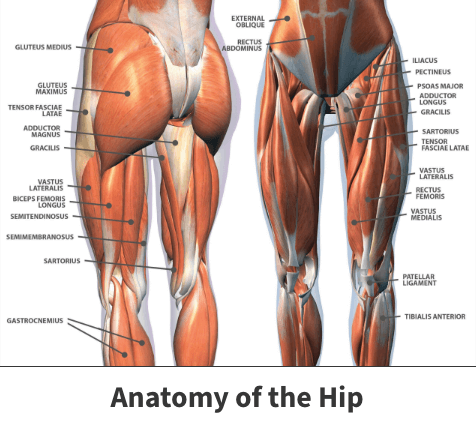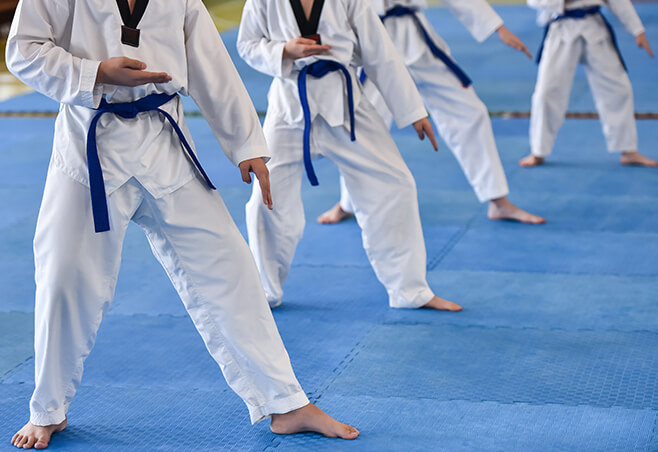Anatomy

The hip is a ball and socket joint. The socket is formed by the large pelvis bone (acetabulum) and the ball is formed by the upper end of the thighbone (femoral head). A slippery tissue known as the articular cartilage covers the surface of the joint, creating a smooth surface that allows for the bones to glide easily across each other.
About
Included among your hip’s muscles are the flexors. The primary hip flexors are the rectus femoris, iliacus, psoas, iliocapsularis, and sartorius muscles. These muscles enable you to bend and lift your knees towards your body. When the flexor muscles or the tendons (soft tissues connecting to nearby bones) become injured, you can experience a hip flexor strain. Note that additional muscles also contribute in some way to flexing the hip.
Flexor strains – tears in the associated muscles or neighboring soft tissues – are divided into three categories, grades 1, 2, and 3.
- Grade 1 strains – This is the least severe injury. In most cases, grade 1 strains are tears involving only a few muscle fibers.
- Grade 2 strains – This is a moderate but often painful injury in which many muscle fibers have been damaged.
- Grade 3 strains – The most severe injury grade, with a complete tear of flexor muscles or surrounding soft tissues.
Causes
Often flexor strains occur when you overuse or overextend flexor muscles. Participation in certain sports increases your risk of developing hip flexor strains. Specific examples include:
- Cycling
- Various martial arts
- Dancing
- Aerobic exercises
- Soccer
- Track and field
Heavy stretching can also result in overextension, leading to muscle tears.

Symptoms
The severity of the symptoms you experience depends on the strain’s grade. Usually, pain is the most prominent symptom you will experience and felt in the front of the hip. Other symptoms that might indicate a flexor strain include:
- Swelling or redness around your hip or thigh region
- Pain that comes on suddenly
- Discomfort when touching the hip or surrounding muscles
- Pain increases when performing actions like walking, stretching, or engaging in any type of exercise
In grade 3 strains, the pain can be so severe that your mobility is limited, and you have trouble performing basic actions such as standing or stretching.
Diagnosis
During the first part of your medical evaluation, your physician will visually examine your hip and ask questions about the sports you play or if you recently experienced any traumatic or forceful event that might have affected your hip.
Flexor strains are not easy to diagnose. Your physician may also use imaging diagnostic tools like X-rays and magnetic resonance imaging (MRIs), which enable them to capture internal pictures of your hip and detect any injuries or other anomalies.
Treatment
Fortunately, most mild to moderate hip flexor strains benefit from home remedies and gentle exercises. Only the severest cases need surgical intervention.
Nonsurgical treatments
Often the first remedy your doctor will prescribe is rest. This means keeping the impacted muscles immobile as much as possible. You’ll also want to avoid engaging in any activities that could lead to a worsening or reaggravation of the strain.
Additionally, several home remedies have proven effective in treating flexor strains. These therapies include:
- Ice application – Placing ice on the affected hip at varying intervals can help bring associated swelling down.
- Over-the-counter medications – If your pain is more than mild, over-the-counter anti-inflammatory medications and pain relievers can ease any associated discomfort.
- Warmth – Occasionally substituting ice for heat with hot showers or heating pads can speed up the recovery process.
- Exercises – Sometimes your hip can respond to gentle stretching exercises. These actions keep the muscles and surrounding tissues strong and enable them to remain movable and flexible.
Surgical treatments
You may need an orthopedic surgeon to repair completely torn muscles causing unbearable pain or significant mobility problems. But reattachment or repair interventions are only indicated in the most severe instances.
The recovery process
Mild strains often improve within two to three weeks. Moderate to severe flexor injuries can take six weeks or longer to heal completely.
Related specialties
- Avascular Necrosis (Osteonecrosis)
- Groin Strains & Pulls
- Hamstring Injuries
- Hip Arthroscopy
- Hip Dislocation
- Hip Fractures
- Hip Hemiarthroplasty
- Hip Impingement Labral Tears
- Hip Muscle Strains
- Hip Pointers & Trochanteric Bursitis
- Iliopsoas Tenotomy
- Labral Tears of the Hip (Acetabular Labrum Tears)
- Osteoarthritis of the Hip
- Osteoporosis
- Pelvic Ring Fractures
- Piriformis Syndrome
- Sports Hernias (Athletic Pubalgia)
- Thigh Fractures
- Thigh Muscle Strains
- Total Hip Arthroplasty
- Total Hip Replacement - Anterior Approach
